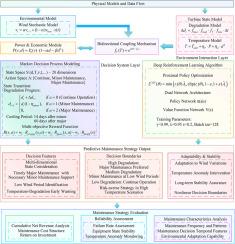风力涡轮机的预测性维护:具有经济可靠性协同优化的物理驱动强化学习策略
IF 9.6
Q1 COMPUTER SCIENCE, ARTIFICIAL INTELLIGENCE
引用次数: 0
摘要
在环境不确定性条件下,风电机组维护优化面临着平衡经济效益与运行可靠性的挑战。传统的维护方法在自适应决策方面存在局限性,导致运营成本和可靠性风险增加。本研究开发了一个基于物理的强化学习框架,该框架将已建立的领域知识与自适应决策算法集成在一起。该方法将物理原理(包括威布尔风动力学和多阶段退化模型)嵌入到强化学习架构中,同时引入双向温度-退化耦合以增强故障预测。高保真仿真环境通过近端策略优化实现策略训练,捕获环境可变性和设备退化之间的复杂相互作用。通过对中国北方风电场运行数据的案例研究,对该框架进行了验证。结果表明,在模拟的19年生命周期内,零故障运行,与传统的定期和基于阈值的维护策略相比,经济性能提高了109.3%和54.5%。该方法将物理约束与智能算法相结合,实现了基于多维状态信息的自适应维修决策。本文章由计算机程序翻译,如有差异,请以英文原文为准。

Predictive maintenance for wind turbines: A physics-driven reinforcement learning strategy with economic-reliability collaborative optimization
Wind turbine maintenance optimization faces challenges in balancing economic efficiency with operational reliability under environmental uncertainty. Traditional maintenance approaches exhibit limitations in adaptive decision-making, leading to increased operational costs and reliability risks. This study develops a physics-informed reinforcement learning framework that integrates established domain knowledge with adaptive decision algorithms. The approach embeds physical principles—including Weibull wind dynamics and multi-stage degradation models—into a reinforcement learning architecture, while introducing bidirectional temperature-degradation coupling for enhanced failure prediction. A high-fidelity simulation environment enables policy training through Proximal Policy Optimization, capturing complex interactions between environmental variability and equipment deterioration. The framework was validated through case study implementation using northern China wind farm operational data. Results demonstrate zero-failure operation over simulated 19-year lifecycles, with economic performance improvements of 109.3 % and 54.5 % compared to conventional periodic and threshold-based maintenance strategies. By integrating physical constraints with intelligent algorithms, the method achieves adaptive maintenance decisions based on multi-dimensional state information.
求助全文
通过发布文献求助,成功后即可免费获取论文全文。
去求助
来源期刊

Energy and AI
Engineering-Engineering (miscellaneous)
CiteScore
16.50
自引率
0.00%
发文量
64
审稿时长
56 days
 求助内容:
求助内容: 应助结果提醒方式:
应助结果提醒方式:


